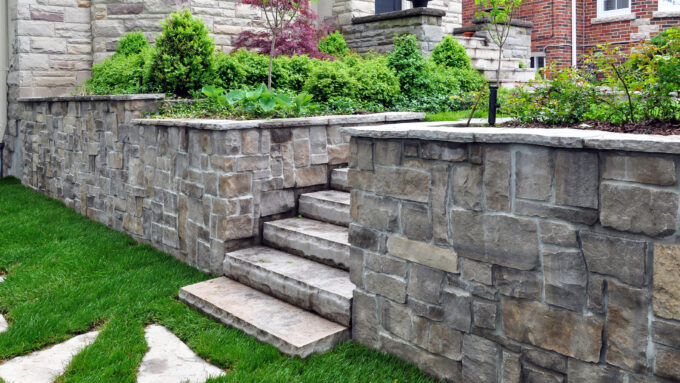Cost Effective and High-Quality Retaining Walls Sunshine Coast: What to Know
Cost Effective and High-Quality Retaining Walls Sunshine Coast: What to Know
Blog Article
Enhancing Home Security: The Duty of Retaining Walls in Soil Retention and Erosion Control
Maintaining walls stand as quiet guardians, playing a critical duty in dirt retention and erosion control. By checking out the nuances of various types, style considerations, building and construction strategies, and maintenance pointers associated with keeping walls, a much deeper understanding of their crucial function in boosting residential or commercial property security arises.
Significance of Retaining Walls in Security
Retaining walls play a critical role in holding back dirt, preventing erosion, and creating level surface areas in sloped areas. By giving architectural assistance, preserving wall surfaces help to rearrange side stress created by soil, preventing landslides and slippage.
Keeping wall surfaces are specifically necessary in hilly or irregular terrains where soil erosion is a common incident. Without sufficient assistance, soil erosion can result in the deterioration of landscapes, jeopardizing the honesty of structures and positioning threats to occupants. Retaining wall surfaces act as barriers, supporting the dirt and stopping it from shifting downhill throughout hefty rains or other environmental stress factors.
In addition, keeping wall surfaces provide lasting benefits by minimizing upkeep expenses associated with soil disintegration and land instability. By buying well-designed keeping walls, residential or commercial property owners can ensure the longevity and sustainability of their landscapes while promoting a visually enticing and safe atmosphere.

Kinds Of Retaining Walls for Erosion Control
Gravity keeping walls are sturdy frameworks that depend on their weight to resist the pressure of the dirt behind them. Cantilever retaining walls, on the other hand, are made with a thicker base and use a lever arm to hold up against the soil stress.
For taller walls or where space is a restraint, anchored preserving wall surfaces are often utilized. When selecting the proper kind of retaining wall surface for erosion control, elements such as dirt make-up, wall height, and website problems should be thoroughly taken into consideration to make certain long-lasting stability and effectiveness.
Layout Considerations for Dirt Retention
The elevation and area of the keeping wall surface are essential elements that influence the general design. Engineers need to also take into consideration the pressure exerted by the preserved dirt and possible side loads to ensure the framework's stability over time.
Moreover, the material choice for the retaining wall surface is crucial in boosting longevity and functionality. Concrete, wood, gabion baskets, and natural rock prevail products used in preserving wall construction, each with its unique benefits and factors to consider. Appropriate drainage systems, such as weep holes and French drains pipes, should be integrated into the style to prevent water build-up behind the wall, which can lead to structural failing and disintegration.
Construction Techniques for Retaining Wall Surfaces
When applying design factors to consider for efficient dirt retention, the building techniques for retaining walls play a vital function in ensuring structural honesty and long-term stability. One usual technique is the gravity wall surface, which counts on the weight and mass of the wall itself to stand up to the pressure of the maintained soil.
One more extensively made use of building and construction strategy is the cantilevered wall, which makes use of a concrete slab foundation that extends in reverse right into the kept dirt. This design gives additional security and is suitable for medium to high keeping wall surfaces. For taller frameworks, reinforced dirt techniques such as making use of geogrids or dirt nails can be used to boost the wall's strength and security.

Upkeep Tips for Property Stability
To make certain long-term property security, regular maintenance techniques are vital for protecting the integrity of retaining wall surfaces and stopping erosion issues. Cleaning up the surface area of the maintaining wall surfaces can likewise aid preserve their architectural stability by eliminating dirt, particles, and greenery that could weaken the wall surface over time.
Along with visual examinations and cleaning, it is very important to inspect the drainage systems connected Discover More Here with the keeping wall surfaces. Ensuring that drains are clear of obstructions and functioning effectively can avoid water accumulation behind the wall surfaces, which can result in stress and possible failure. Effectively functioning drainage systems are essential for taking care of water flow and minimizing the danger of disintegration.
On a regular basis checking and preserving retaining wall surfaces according to these suggestions can expand their life expectancy and add to the general security of the home.
Final Thought
In verdict, maintaining wall surfaces visit this page play an essential function in improving building stability by stopping soil disintegration and maintaining soil in location. Normal maintenance of maintaining wall surfaces is vital to make certain lasting security and protection against erosion.
For taller wall surfaces or where space is a constraint, anchored maintaining wall surfaces are commonly utilized. These wall surfaces make use of cords or strips that are secured right into the soil or rock behind the wall to give added assistance. When selecting the proper type of maintaining wall for disintegration control, factors such as dirt structure, wall elevation, and site problems should be thoroughly taken into consideration to make sure long-lasting security and effectiveness.
One usual strategy is the gravity wall, which depends on the weight and mass of the wall surface itself to stand up to the pressure of the retained soil. Cleansing the surface area of the retaining walls can also help maintain their architectural stability by eliminating dirt, particles, and plant Discover More Here life that can deteriorate the wall over time.
Report this page